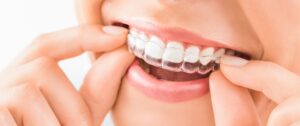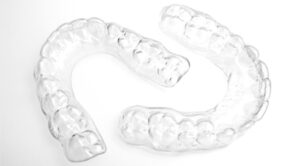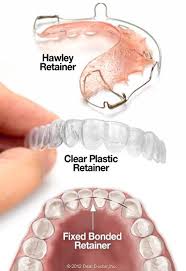March 24th, 2021
Retainers are a critical part of your orthodontic treatment. If your retainer was fitting well the day you received it from your orthodontist and now does not feel like it is fitting properly, it is important to determine why that may be.

If a retainer was fitting well at the initial placement and now feels tight and is causing you pain, it is generally one of two problems. The retainer has either been deformed in some way or the teeth have moved. A retainer should not deform or change shape with normal use, but there are ways that a retainer can be damaged and deformed other than your dog chewing it up or accidentally stepping on it. Here in Arizona, I have seen retainers left in a hot car in the brutal summer heat become slightly warped. Cleaning a retainer in extremely hot water (boiling or close to it) can also have a similar effect.
When a retainer feels tight and makes your teeth sore, most of the time it is because you have not been wearing it enough. Even a slight movement that is hard to visually see with your eyes can be enough to make your retainer feel tight. The easiest solution for this problem is to go back to wearing your retainer full-time for a few days to a few weeks (depending on how much time you have missed wearing it) to get back on track. The teeth will generally mold back to the shape of the retainer and the soreness and tightness will go away. Be careful though – you can reach a “point-of-no-return” in which the teeth have moved so much that the retainer no longer fits and you will have to realign your teeth with braces or Invisalign. If you are having problems with a retainer, please give us a call. We would be happy to help you determine the best path forward.
June 1st, 2020
The big day has finally arrived! After several months and sometimes a couple of years in orthodontic treatment, you are done with your Invisalign or braces! Woohoo!! However, it is important to understand that your orthodontic treatment is not yet finished. Taking your braces off and then just walking out the door would be like getting your car washed and waxed and then driving out into a rainstorm full of muddy puddles.

Invisalign and braces move teeth in your mouth by applying a consistent gentle pressure to the roots of your teeth which stimulates the bone around your teeth to remodel. This is what allows orthodontists to straighten your teeth. When your braces are removed, the bone around the roots of your teeth is not yet fully “set”. Removing braces and not wearing retainers would be similar to breaking your arm and then not putting a cast on it while it healed. If you do this, the bone may not heal in its proper place.
When braces are first removed, the teeth are somewhat unstable and need to time to stabilize into their final position. This is what makes retainers such an important part of orthodontic treatment. Retainers “retain” teeth in their final position. Most patients need to wear retainers full-time for at least a few weeks after getting their braces or Invisalign off to allow their teeth to stabilize. After a period of time, your orthodontist will tell you when it is OK to reduce the amount of time that you wear your retainers. The amount of time can vary between patients depending on where your teeth started. Teeth never reach a point where they are 100% stable because of all the forces constantly being applied to your teeth by chewing, talking, and swallowing. However, most patients can get to the point where they just wear their retainers at night while they sleep to keep their teeth looking straight and fitting well. Your orthodontist can guide you through the process of getting your braces off to make sure you have a beautiful smile for the rest of your life.
December 10th, 2019
Retainers are the most important aspect of orthodontic treatment. If retainers are not properly worn, all your hard work to achieve the perfect smile and a healthy bite using braces or Invisalign can simply go to waste. One important aspect of maintaining your retainers is keeping them clean and free of the harmful buildup of the acid-producing bacteria found in dental plaque (the white fuzzy stuff that collects on your teeth when you don’t brush well). The easiest way to prevent this from happening is to gently brush your retainers with your toothbrush and toothpaste every time you brush your teeth.
In general, if you are brushing your retainers as often as you brush your teeth, your retainers will stay relatively clean and free of bacteria buildup. If you are “out and about” and don’t have access to your toothbrush, you should gently rinse your retainers with clean water and then brush them when you do have access to a toothbrush and toothpaste. This will prevent the proteins and minerals in your saliva from drying on the retainer and creating what might be referred to as “hard water” stains on your retainer.

When you are no longer wearing your retainer full-time and only while you sleep, a thorough cleaning in the morning after waking up should be sufficient to keep your retainers looking like new. Sometimes despite your best efforts, you will start to get some buildup collecting on your retainers. The best way to get back on track is to soak the retainers in a denture cleaner like Efferdent or Polydent or a generic equivalent. These cleaners are specifically designed for the materials that retainers are made of. However, if you have a retainer with solder joints (rarely used in our office), make sure you use a non-persulfate cleanser like Dentasoak instead of Efferdent or Polydent. Please do not use household cleaners like bleach or other abrasive cleaners on your retainers. This is dangerous if there is any residual cleaner left on the retainer and will be harmful to the retainer itself over time.
Follow these simple guidelines, and you should have a happy and healthy mouth for many years to come.
June 28th, 2019
The simple answer is yes. There are two main reasons why. First, your gums have little elastic fibers in them that attach to the teeth. There is actually a protein in your gums called elastin. The elastic fibers in your gums act like little rubber bands. When you straighten a crooked tooth, the elastic fibers get stretched out and want to recoil to their original positions. These fibers “remember” where the teeth were before treatment began and are the main cause of teeth getting crooked again after orthodontic treatment. By the way, a common misconception is that wisdom teeth are what cause your orthodontic treatment to relapse. This is actually not true - patients who were born without wisdom teeth have the same amount of orthodontic relapse.
Second, teeth naturally tend to move and adjust as you age – regardless of whether you have had orthodontic treatment or not – unless you are wearing retainers.
If you stopped wearing your retainer and your teeth have shifted, all is not lost. Straightening teeth the second time around tends to be easier and faster. A lot of the work was already done the first time around. Invisalign is a great option for those who have had previous treatment with braces but have had some orthodontic relapse. Bonded fixed retainers are a nice option for holding teeth in position for the long term. Check out our website to learn more about retainers.

Remember, it’s easy to slip your retainers in at night before you go to bed to keep your smile straight and beautiful. If you make retainers part of your nighttime routine, you can enjoy beautiful, straight teeth for the rest of your life. If you have had some relapse, please give us a call to get your smile back on track. You’ll be happy you did!











 Website Powered by Sesame 24-7™
Website Powered by Sesame 24-7™